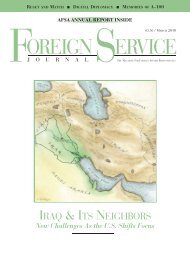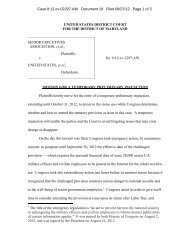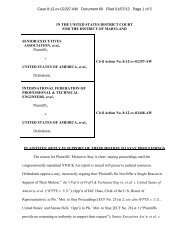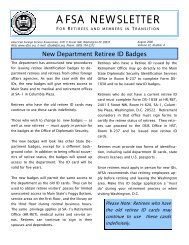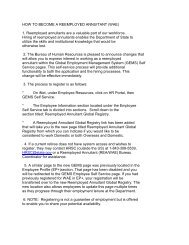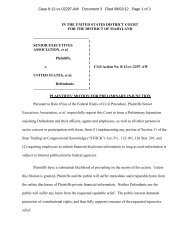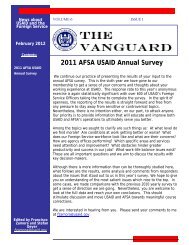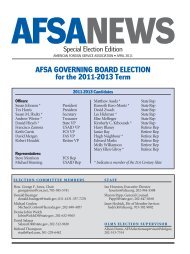F OCUS - American Foreign Service Association
F OCUS - American Foreign Service Association
F OCUS - American Foreign Service Association
Create successful ePaper yourself
Turn your PDF publications into a flip-book with our unique Google optimized e-Paper software.
L E T T E R S<br />
<br />
gressional authority in the stead of<br />
under-resourced civilian agencies. Reestablishing<br />
the proper authorities to<br />
State and USAID will begin to repair<br />
this problem. Congress must also give<br />
civilian institutions the personnel, funding<br />
and guidance necessary to reclaim<br />
the execution of non-military activities<br />
and oversight of non-combat operations.<br />
To achieve our top foreign policy<br />
objectives, the U.S. government must<br />
use all its elements of power. To do<br />
otherwise risks furthering the perception<br />
that <strong>American</strong> foreign policy is<br />
principally implemented with the bayonet.<br />
Ron Capps<br />
FSO, retired<br />
Bethesda, Md.<br />
Editor’s Note: Mr. Capps, the 2007<br />
co-winner of AFSA’s William R. Rivkin<br />
Award for constructive dissent by a<br />
mid-level <strong>Foreign</strong> <strong>Service</strong> officer, is a<br />
program manager for peacekeeping<br />
with Refugees International.<br />
The Military Should Run PRTs<br />
Despite all the good advice in Captain<br />
Sean Walsh’s article in the February<br />
Journal (“Improving the PRT-Military<br />
Professional Relationship”), its<br />
basis is a bit shocking to this veteran of<br />
the pacification program in Vietnam<br />
(1969-1971). Specifically, why aren’t<br />
the Provincial Reconstruction Teams in<br />
Iraq embedded within the military<br />
brigade structure?<br />
In the July-August 2008 Journal, we<br />
learned from William Maley’s article<br />
(“NATO and Afghanistan: Made for<br />
Each Other?”) that in establishing the<br />
PRT program in Afghanistan, we drew<br />
upon the Civil Operations and Revolutionary<br />
Development Support model<br />
from Vietnam. In Vietnam, all State,<br />
USAID and military personnel in<br />
CORDS worked for the commander<br />
of the Military Assistance Command<br />
Vietnam: General Creighton Abrams,<br />
and his deputy, Ambassador William<br />
Colby. But in Iraq, apparently the decision<br />
was made to separate reconstruction<br />
operations from military<br />
operations, at least in terms of the<br />
chain of command.<br />
Much of Capt. Walsh’s good advice<br />
about getting along with the Army<br />
would pertain regardless of the PRT organizational<br />
model. But given counterinsurgency<br />
strategy, where the Army<br />
mission of security rightly comes first,<br />
having separate chains of command<br />
makes no sense. The PRT and its mission<br />
should be “organic” to the brigade<br />
structure. This means the brigade<br />
would “own” the PRT just as it “owns”<br />
its artillery capability.<br />
By making the PRT organic to the<br />
brigade, the brigade then owns, and is<br />
responsible for, the success of its mission,<br />
eliminating any need for the team<br />
to “bum” rides or other brigade support.<br />
However boneheaded a brigade<br />
commander may be about the<br />
need to win hearts and minds, he will<br />
respond to such requests if he knows a<br />
general is going to ask him how his PRT<br />
is doing.<br />
In The Gamble, the new book on<br />
Iraq by Thomas Ricks, we see that it<br />
was Defense Secretary Donald Rumsfeld’s<br />
decision not to support the PRTs.<br />
That alone is probably a very good reason<br />
to consolidate the counterinsurgency<br />
mission in Iraq.<br />
Alfred R. Barr<br />
FSO, retired<br />
Washington, D.C.<br />
The Ground Truth About<br />
Virtual Presence Posts<br />
Shawn Dorman’s January article,<br />
“Global Repositioning in Perspective,”<br />
includes a brief and mostly balanced<br />
description of Virtual Presence Posts.<br />
The article accurately notes that the<br />
relative success of a VPP fundamentally<br />
depends on each mission’s commitment<br />
to increasing outreach to important<br />
locales with no permanent U.S.<br />
diplomatic presence.<br />
The article also includes an anonymous<br />
remark from a “Washingtonbased<br />
FSO” who questions the value of<br />
VPPs. The officer is not accurately informed.<br />
Over the last five years, posts<br />
through their own serious and sustained<br />
efforts have established 56<br />
VPPs, up from only five in 2003. Moreover,<br />
over just the past year, posts have<br />
established 21 VPPs, including at least<br />
one new VPP in each regional bureau.<br />
Twelve new ones were created in China<br />
alone.<br />
The significant growth in the use of<br />
Virtual Presence Posts reflects the recognized<br />
benefits and real-world results<br />
associated with a well-run VPP program.<br />
For example, VPPs provide<br />
posts with the means for more organized<br />
and focused mission travel, for better<br />
interagency coordination and for<br />
more strategic application of program<br />
and outreach resources.<br />
Another point of clarification: the<br />
Journal article reports that “in some<br />
countries, the VPP model does serve as<br />
a substitute for the <strong>American</strong> Presence<br />
Post.” This has been true at a few posts,<br />
yet VPPs are always more than just<br />
stand-ins for APPs. VPPs help coordinate<br />
the mission, involving all relevant<br />
sections with a mix of traditional diplomacy<br />
(travel, programs, exchanges) and<br />
modern technologies (branded Web<br />
sites, electronic communication) in<br />
reaching out to important cities, communities<br />
or countries. For this reason,<br />
VPPs have been used as a “bridge”<br />
prior to launching an APP, ensuring<br />
8 F O R E I G N S E R V I C E J O U R N A L / A P R I L 2 0 0 9



